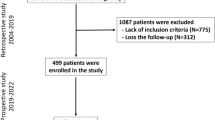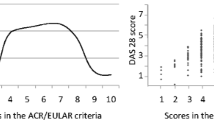Abstract
The purpose of this study was to identify the prevalence and prognostic factors of clinical remission in patients with rheumatoid arthritis (RA). The Thai Army Rheumatoid Arthritis Cohort (TARAC) patients were included if baseline data were available. Clinical remission was defined as 28-joint count disease activity scores (DAS28) <2.6 in the last two consecutive visits, at least 3 months apart. Three hundred and thirty-five patients were enrolled, and 89.9 % were female. Mean (SD) age was 61 years (11.4), and mean disease duration was 145.9 months (93.7). Rheumatoid factor (RF) and anti-citrullinated protein antibody (ACPA) were positive in 69.9 and 67.8 %, respectively. Eighty-nine percent of patients were treated with synthetic DMARDs, of which 29 % received monotherapy. The combination of biologic and synthetic DMARDs was used in 10.4 % of the patients. Clinical remission was observed in 49 patients (14.6 %). Early diagnosis and treatment within 12 months of onset (odds ratio (OR) 1.95, 95 % confidence interval (CI) 1.02–3.74, p = 0.04), rheumatoid factor negativity (OR 2.10, 95 % CI 1.04–4.21, p = 0.04) and good EULAR response at the end of the first year of treatment (OR 2.75, 95 % CI 1.08–6.99, p = 0.03) were associated with clinical remission in univariate analysis. In multivariate regression analysis, only a good EULAR response at the first year was significantly correlated with clinical remission in this study (OR 3.1, 95 % CI 1.15–8.36, p = 0.03). Although remission is currently a treatment goal in patients with RA, only one-seventh of patients have achieved sustained clinical remission in clinical practice. The good EULAR response at the end of the first year was an independent predictive factor of clinical remission.
Similar content being viewed by others
References
Maini R, St Clair EW, Breedveld F, Furst D, Kalden J, Weisman M, Smolen J, Emery P, Harriman G, Feldmann M, Lipsky P (1999) Infliximab (chimeric anti-tumour necrosis factor alpha monoclonal antibody) versus placebo in rheumatoid arthritis patients receiving concomitant methotrexate: a randomised phase III trial. ATTRACT Study Group. Lancet 354:1932–1939
Smolen JS, Kalden JR, Scott DL, Rozman B, Kvien TK, Larsen A, Loew-Friedrich I, Oed C, Rosenburg R (1999) Efficacy and safety of leflunomide compared with placebo and sulphasalazine in active rheumatoid arthritis: a double-blind, randomised, multicentre trial. European Leflunomide Study Group. Lancet 353:259–266
Weinblatt ME, Kremer JM, Bankhurst AD, Bulpitt KJ, Fleischmann RM, Fox RI, Jackson CG, Lange M, Burge DJ (1999) A trial of etanercept, a recombinant tumor necrosis factor receptor:Fc fusion protein, in patients with rheumatoid arthritis receiving methotrexate. N Engl J Med 340:253–259. doi:10.1056/nejm199901283400401
Breedveld FC, Weisman MH, Kavanaugh AF, Cohen SB, Pavelka K, van Vollenhoven R, Sharp J, Perez JL, Spencer-Green GT (2006) The PREMIER study: a multicenter, randomized, double-blind clinical trial of combination therapy with adalimumab plus methotrexate versus methotrexate alone or adalimumab alone in patients with early, aggressive rheumatoid arthritis who had not had previous methotrexate treatment. Arthritis Rheum 54:26–37. doi:10.1002/art.21519
Alcorn N, Saunders S, Madhok R (2009) Benefit-risk assessment of leflunomide: an appraisal of leflunomide in rheumatoid arthritis 10 years after licensing. Drug Saf 32:1123–1134. doi:10.2165/11316650-000000000-00000
Gossec L, Dougados M, Goupille P, Cantagrel A, Sibilia J, Meyer O, Sany J, Daures JP, Combe B (2004) Prognostic factors for remission in early rheumatoid arthritis: a multiparameter prospective study. Ann Rheum Dis 63:675–680. doi:10.1136/ard.2003.010611
Listing J, Strangfeld A, Rau R, Kekow J, Gromnica-Ihle E, Klopsch T, Demary W, Burmester GR, Zink A (2006) Clinical and functional remission: even though biologics are superior to conventional DMARDs overall success rates remain low–results from RABBIT, the German biologics register. Arthritis Res Ther 8:R66. doi:10.1186/ar1933
Forslind K, Hafstrom I, Ahlmen M, Svensson B (2007) Sex: a major predictor of remission in early rheumatoid arthritis? Ann Rheum Dis 66:46–52. doi:10.1136/ard.2006.056937
Mancarella L, Bobbio-Pallavicini F, Ceccarelli F, Falappone PC, Ferrante A, Malesci D, Massara A, Nacci F, Secchi ME, Manganelli S, Salaffi F, Bambara ML, Bombardieri S, Cutolo M, Ferri C, Galeazzi M, Gerli R, Giacomelli R, Grassi W, Lapadula G, Cerinic MM, Montecucco C, Trotta F, Triolo G, Valentini G, Valesini G, Ferraccioli GF (2007) Good clinical response, remission, and predictors of remission in rheumatoid arthritis patients treated with tumor necrosis factor-alpha blockers: the GISEA study. J Rheumatol 34:1670–1673
Vazquez I, Graell E, Gratacos J, Canete JD, Vinas O, Ercilla MG, Gomez A, Hernandez MV, Rodriguez-Cros JR, Larrosa M, Sanmarti R (2007) Prognostic markers of clinical remission in early rheumatoid arthritis after two years of DMARDs in a clinical setting. Clin Exp Rheumatol 25:231–238
Kristensen LE, Kapetanovic MC, Gulfe A, Soderlin M, Saxne T, Geborek P (2008) Predictors of response to anti-TNF therapy according to ACR and EULAR criteria in patients with established RA: results from the South Swedish Arthritis Treatment Group Register. Rheumatology (Oxford) 47:495–499. doi:10.1093/rheumatology/ken002
Hetland ML, Christensen IJ, Tarp U, Dreyer L, Hansen A, Hansen IT, Kollerup G, Linde L, Lindegaard HM, Poulsen UE, Schlemmer A, Jensen DV, Jensen S, Hostenkamp G, Ostergaard M (2010) Direct comparison of treatment responses, remission rates, and drug adherence in patients with rheumatoid arthritis treated with adalimumab, etanercept, or infliximab: results from eight years of surveillance of clinical practice in the nationwide Danish DANBIO registry. Arthritis Rheum 62:22–32. doi:10.1002/art.27227
Furst DE, Pangan AL, Harrold LR, Chang H, Reed G, Kremer JM, Greenberg JD (2011) Greater likelihood of remission in rheumatoid arthritis patients treated earlier in the disease course: results from the Consortium of Rheumatology Researchers of North America registry. Arthritis Care Res (Hoboken) 63:856–864. doi:10.1002/acr.20452
Hyrich KL, Watson KD, Lunt M, Symmons DP (2011) Changes in disease characteristics and response rates among patients in the United Kingdom starting anti-tumour necrosis factor therapy for rheumatoid arthritis between 2001 and 2008. Rheumatology (Oxford) 50:117–123. doi:10.1093/rheumatology/keq209
de Punder YM, Fransen J, Kievit W, Houtman PM, Visser H, van de Laar MA, van Riel PL (2012) The prevalence of clinical remission in RA patients treated with anti-TNF: results from the Dutch Rheumatoid Arthritis Monitoring (DREAM) registry. Rheumatology (Oxford) 51:1610–1617. doi:10.1093/rheumatology/kes078
Arnett FC, Edworthy SM, Bloch DA, McShane DJ, Fries JF, Cooper NS, Healey LA, Kaplan SR, Liang MH, Luthra HS et al (1988) The American Rheumatism Association 1987 revised criteria for the classification of rheumatoid arthritis. Arthritis Rheum 31:315–324
Aletaha D, Neogi T, Silman AJ, Funovits J, Felson DT, Bingham CO 3rd, Birnbaum NS, Burmester GR, Bykerk VP, Cohen MD, Combe B, Costenbader KH, Dougados M, Emery P, Ferraccioli G, Hazes JM, Hobbs K, Huizinga TW, Kavanaugh A, Kay J, Kvien TK, Laing T, Mease P, Menard HA, Moreland LW, Naden RL, Pincus T, Smolen JS, Stanislawska-Biernat E, Symmons D, Tak PP, Upchurch KS, Vencovsky J, Wolfe F, Hawker G (2010) 2010 Rheumatoid arthritis classification criteria: an American College of Rheumatology/European League Against Rheumatism collaborative initiative. Arthritis Rheum 62:2569–2581. doi:10.1002/art.27584
Prevoo ML, van ‘t Hof MA, Kuper HH, van Leeuwen MA, van de Putte LB, van Riel PL (1995) Modified disease activity scores that include twenty-eight-joint counts. Development and validation in a prospective longitudinal study of patients with rheumatoid arthritis. Arthritis Rheum 38:44–48
Fransen J, Creemers MC, Van Riel PL (2004) Remission in rheumatoid arthritis: agreement of the disease activity score (DAS28) with the ARA preliminary remission criteria. Rheumatology (Oxford) 43:1252–1255. doi:10.1093/rheumatology/keh297
van Gestel AM, Haagsma CJ, van Riel PL (1998) Validation of rheumatoid arthritis improvement criteria that include simplified joint counts. Arthritis Rheum 41:1845–1850. doi:10.1002/1529-0131(199810)41:10<1845::aid-art17>3.0.co;2-k
Fransen J, van Riel PL (2005) The Disease Activity Score and the EULAR response criteria. Clin Exp Rheumatol 23:S93–S99
Sokka T, Hetland ML, Makinen H, Kautiainen H, Horslev-Petersen K, Luukkainen RK, Combe B, Badsha H, Drosos AA, Devlin J, Ferraccioli G, Morelli A, Hoekstra M, Majdan M, Sadkiewicz S, Belmonte M, Holmqvist AC, Choy E, Burmester GR, Tunc R, Dimic A, Nedovic J, Stankovic A, Bergman M, Toloza S, Pincus T (2008) Remission and rheumatoid arthritis: data on patients receiving usual care in twenty-four countries. Arthritis Rheum 58:2642–2651. doi:10.1002/art.23794
Prince FH, Bykerk VP, Shadick NA, Lu B, Cui J, Frits M, Iannaccone CK, Weinblatt ME, Solomon DH (2012) Sustained rheumatoid arthritis remission is uncommon in clinical practice. Arthritis Res Ther 14:R68. doi:10.1186/ar3785
Makinen H, Kautiainen H, Hannonen P, Mottonen T, Leirisalo-Repo M, Laasonen L, Korpela M, Blafield H, Hakola M, Sokka T (2007) Sustained remission and reduced radiographic progression with combination disease modifying antirheumatic drugs in early rheumatoid arthritis. J Rheumatol 34:316–321
Molenaar ET, Voskuyl AE, Dinant HJ, Bezemer PD, Boers M, Dijkmans BA (2004) Progression of radiologic damage in patients with rheumatoid arthritis in clinical remission. Arthritis Rheum 50:36–42. doi:10.1002/art.11481
Brown AK, Conaghan PG, Karim Z, Quinn MA, Ikeda K, Peterfy CG, Hensor E, Wakefield RJ, O'Connor PJ, Emery P (2008) An explanation for the apparent dissociation between clinical remission and continued structural deterioration in rheumatoid arthritis. Arthritis Rheum 58:2958–2967. doi:10.1002/art.23945
Hyrich KL, Watson KD, Silman AJ, Symmons DP (2006) Predictors of response to anti-TNF-alpha therapy among patients with rheumatoid arthritis: results from the British Society for Rheumatology Biologics Register. Rheumatology (Oxford) 45:1558–1565. doi:10.1093/rheumatology/kel149
Anderson JJ, Wells G, Verhoeven AC, Felson DT (2000) Factors predicting response to treatment in rheumatoid arthritis: the importance of disease duration. Arthritis Rheum 43:22–29. doi:10.1002/1529-0131(200001)43:1<22::aid-anr4>3.0.co;2-9
Pease CT, Bhakta BB, Devlin J, Emery P (1999) Does the age of onset of rheumatoid arthritis influence phenotype?: a prospective study of outcome and prognostic factors. Rheumatology (Oxford) 38:228–234
Verstappen SM, van Albada-Kuipers GA, Bijlsma JW, Blaauw AA, Schenk Y, Haanen HC, Jacobs JW (2005) A good response to early DMARD treatment of patients with rheumatoid arthritis in the first year predicts remission during follow up. Ann Rheum Dis 64:38–43. doi:10.1136/ard.2003.014928
Acknowledgments
This study was supported by a research grant from the Thai Rheumatism Association. This manuscript was verified to be correct English by Stephen John Pinder, a native speaker experienced in medical English.
Conflict of interest
The authors declare that there are no conflicts of interest.
Author information
Authors and Affiliations
Corresponding author
Rights and permissions
About this article
Cite this article
Darawankul, B., Chaiamnuay, S., Pakchotanon, R. et al. The good EULAR response at the first year is strongly predictive of clinical remission in rheumatoid arthritis: results from the TARAC cohort. Clin Rheumatol 34, 43–49 (2015). https://doi.org/10.1007/s10067-014-2749-1
Received:
Revised:
Accepted:
Published:
Issue Date:
DOI: https://doi.org/10.1007/s10067-014-2749-1




